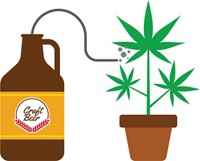Advertisement
Grab your lab coat. Let's get started
Welcome!
Welcome!
Create an account below to get 6 C&EN articles per month, receive newsletters and more - all free.
It seems this is your first time logging in online. Please enter the following information to continue.
As an ACS member you automatically get access to this site. All we need is few more details to create your reading experience.
Not you? Sign in with a different account.
Not you? Sign in with a different account.
ERROR 1
ERROR 1
ERROR 2
ERROR 2
ERROR 2
ERROR 2
ERROR 2
Password and Confirm password must match.
If you have an ACS member number, please enter it here so we can link this account to your membership. (optional)
ERROR 2
ACS values your privacy. By submitting your information, you are gaining access to C&EN and subscribing to our weekly newsletter. We use the information you provide to make your reading experience better, and we will never sell your data to third party members.
Fermentation
Newscripts
New lives for old beers
by Arminda Downey-Mavromatis
August 29, 2020
| A version of this story appeared in
Volume 98, Issue 33
Reverse engi-beer-ing

Pete Jones, a beer historian with the Lost Lagers consultancy, wasn’t on the lookout for a beer to recreate when he stumbled across the lab report that would become Washington, D.C.–based Right Proper Brewing Company’s Senate Beer. He was examining Korean War–era documents related to the Defense Production Act when he found documents that Christian Heurich Brewing Company, also in Washington, D.C., created to argue for a greater allocation of tin for their beer cans. The brewery needed more tin because a recent batch of beer had gone bad, a fact they demonstrated with pages of laboratory analysis of the beer alongside testimony from buyers about the beer’s flavor.
The discovery was especially exciting to Kim Bender, executive director at the Heurich House Museum, as much of the archival information about Heurich Brewing was destroyed in a fire. “This is a really important, golden document for us,” Bender tells Newscripts.
The report sparked an idea in Bender, who later reached out to Tom Shellhammer, a professor of brewing science at Oregon State University (OSU), to see if they could recreate the Senate Beer. They would eventually team up with Right Proper Brewing Company to produce a special run of the beer. Bender passed along testimonials from the buyers to Shellhammer and Jeff Clawson, who runs the OSU research brewery, as well as chemical analyses created by two companies Heurich Brewing had consulted in the 1940s.
The analyses were “a smoking gun,” Clawson tells Newscripts. “It gave me the alcohol content, and it gave me the color of the beer.”
The beer was “a typical lager beer,” Shellhammer says, “made with corn adjuncts.”
Not all elements of the recipe were as clear-cut. “The hopping part was unclear,” Shellhammer says, with the reports only detailing a general profile of the hops used. They did, however, find invoices for Oregon seedless hops, which OSU’s hop breeder Shaun Townsend deduced would have been the Cluster hop variety in the 1940s. In another historical callback, the OSU team used a yeast variety that would have been commonly used in German lager beers at the time. The malt was determined more circuitously from the lab report and through spectrophotometry.
The grist-mashing regimen was outlined in the report, too, down to temperature. “The temperature that [Heurich Brewing] used was not Celsius or Fahrenheit, but Réaumur,” Clawson recalls, a strange but unsurprising fact, as the Réaumur scale, based on the temperature of water at standard atmospheric pressure, was used in western Europe in the 19th and 20th centuries.
There are of course some differences between the historic Senate Beer and the Right Proper recreation. The “double mash” originally used by Heurich Brewing involved boiling the corn with some malt to gelatinize the corn before adding the gelatinous mix to the second malt mash. Shellhammer notes that most craft breweries today don’t have the set up for a double mash. For the Senate Beer, Right Proper instead uses adjuncts that are pregelatinized.
“It’s such a simple beer, and I like to point out that it’s incredibly difficult to make,” Thor Cheston, the cofounder of Right Proper Brewing Company, tells Newscripts. The Senate Beer takes longer to brew than some of Right Proper’s other beers, as lagers require longer fermentation times.
The Senate Beer, it seems, is worth the wait. Since its debut in 2019, the beer has been such a success that Cheston plans on making it a regular beer in Right Proper’s rotation.
Brewing up Christmas

When the COVID-19 pandemic forced bars and pubs in Ireland to close their doors, kegs of beer were left untouched within. Guinness ensured not a drop went to waste, collecting millions of liters of its beer and disposing of it in unusual ways. Much of the beer went to Christmas tree farms and willow plantations in Ireland, where the beer provided nutrients for the trees.
The beer was also converted into biogas through anaerobic digestion. Aidan Crowe, the director of operations at Guinness’s famous St. James Gate Brewery, told UK-based PA Media that the company is “quite optimistic, in the long term, that biogas can be a suitable fuel source for us to use here in the brewery.”
Newscripts is glad the beer could be repurposed so sustainably and grateful for an excuse to listen to holiday music in the summer.
Please send comments and suggestions to newscripts@acs.org.





Join the conversation
Contact the reporter
Submit a Letter to the Editor for publication
Engage with us on Twitter